 W
WAphanius danfordii, the Kızılırmak toothcarp or Sultan Sazlığı toothcarp, is a species of killifish belonging to the family Cyprinodontidae. It is endemic to the Kızılırmak River and the upper Seyhan River drainage systems and is now restricted to a few locations in the Sultan Sazlığı marshes. Though little data is available, the population of the fish seems to be declining. The International Union for Conservation of Nature has rated its conservation status as being "critically endangered" and fears it may become extinct in the wild if the drainage of the marshes continues.
 W
WThe black wrasse is a species of wrasse native to the eastern Pacific Ocean around Cocos Island, the Revillagigedo Islands, Tres Marias Islands, and the Galapagos. This species prefers areas with rocky bottoms at depths from 1 to 3 m. It can reach 12.5 cm (4.9 in) in total length.
 W
WThe blacktip poacher is a fish in the family Agonidae (poachers). It was described by Charles Henry Gilbert in 1890. It is a marine, deep water-dwelling fish which is known from British Columbia, Canada to Baja California, Mexico, in the eastern Pacific Ocean. It dwells at a depth range of 18–400 metres, and inhabits soft benthic sediments. Males can reach a maximum total length of 19 centimetres.
 W
WThe bluespotted poacher is a fish in the family Agonidae (poachers). It was described by Charles Henry Gilbert in 1890, originally in the genus Xenochirus. It is a marine, deep water-dwelling fish which is known from British Columbia, Canada to northern central Baja California, Mexico, in the eastern Pacific Ocean. It dwells at a depth range of 73–373 metres, and inhabits soft benthic sediments. Males can reach a maximum total length of 18 centimetres.
 W
WBothrocara brunneum, the twoline eelpout, is a benthic species of fish of the family Zoarcidae. The species is the only fish of the eelpouts to have two lateral lines and short blunt-ended gill rakers. The species has a wide range across the northeastern Pacific Ocean, between the Bering Sea and the shores of San Francisco, and from Attu Island to the Baja California Peninsula.
 W
WCampichthys tryoni is a species of marine fish of the family Syngnathidae. Little is known of this species, but the specimens that have been collected were found on the Queensland coast off of northeastern Australia. It is a rare mainly tan coloured pipefish with brownish markings, it has a white blotch over the eyes, a pale patch above the operculum and it has small white dots along its back and tail. The males frequently show irregular dark barring along their ventral surface. This species is ovoviviparous, with males carrying eggs in a brood pouch until giving birth to live young. The largest known specimen is 7.2 centimetres (2.8 in) long, while males may brood at roughly 6–6 centimetres (2.4–2.4 in). The species was described by James Douglas Ogilby in 1890 from a specimen collected in Moreton Bay, Queensland in 1886 and the specific name honours his friend, Mr Henry Tryon, with whom he enjoyed a collecting trip in Moreton Bay. It is a listed Marine species in Australia under the Environment Protection and Biodiversity Conservation Act 1999.
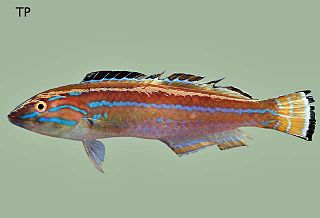 W
WThe Cape wrasse is a species of wrasse native to the eastern Pacific Ocean from Baja California to Colombia, including Cocos Island, Malpelo Island, and the Galapagos. It is a deep-water species recorded as occurring down to about 150 m (490 ft). This species grows to 16.2 cm (6.4 in) in standard length. This species is the only known member of its genus.
 W
WChaenopsis alepidota, the orangethroat pikeblenny, is a species of chaenopsid blenny found in the eastern Pacific Ocean from California to the Gulf of California. It lives in holes excavated by worms in sandy areas.
 W
WThe arroyo chub is a cyprinid fish found only in the coastal streams of southern California, United States.
 W
WThe deepsea sole is a flatfish of the family Pleuronectidae. It is a bathydemersal fish that lives on muddy bottoms at depths of between 41 and 1,800 metres, though it is most often found at depths of 500 to 950 metres. Its native habitat is the northern Pacific, from Japan to the Gulf of Alaska and down the Pacific coasts of Canada and the USA as far south as Mexico. It grows up to 47 centimetres (19 in) in length.
 W
WEumecichthys fiski, the unicorn crestfish or unicornfish, is a very rare, little-known species of crestfish in the family Lophotidae, and the only member of the genus Eumecichthys. It likely has a worldwide distribution, having been first discovered offshore of Kalk Bay, South Africa, and subsequently reported from the Sea of Japan, southwest Florida, Clarion Island off Mexico, Hawaii, and India. A report from the Bering Sea may have been in error. It is found in the bathypelagic zone, at a depth of around 1,000 m (3,300 ft).
 W
WThe Galapagos snake eel is an eel in the family Ophichthidae. It was described by David Starr Jordan and Charles Harvey Bollman in 1890. It is a marine, tropical eel which is known from the eastern central and southeastern Pacific Ocean, including Colombia, the Gulf of California, Costa Rica, and the Galapagos Islands in Ecuador. It dwells at a depth range of 3 to 30 metres, and inhabits reefs, preferring to live in areas bearing a mixture of boulders, gravel and sand. Males can reach a maximum total length of 71 centimetres (28 in).
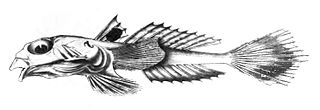 W
WCallionymus carebares, the Indian deepwater dragonet, is a species of dragonet native to the western Indian Ocean where it occurs at depths of from 135 to 330 metres. This species grows to a length of 18 centimetres (7.1 in) TL.
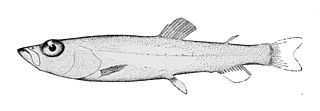 W
WThe southern smoothtongue or California smoothtongue is a type of ray-finned fish in the deep-sea smelt family Bathylagidae, that can grow to a length of 15 centimetres (6 in) TL. This fish is native to the northeastern Pacific Ocean from British Columbia to Oregon, and the Gulf of California where it is found at depths of 100 to 850 metres.
 W
WLythrypnus dalli, the Blue-banded goby or Catalina Goby is a species of goby native to the eastern Pacific from Monterey Bay (California) to northern Peru, including the Gulf of California. It can be found in coastal waters at depths of from 0 to 76 metres with rocky substrates in which there are crevices for concealment. It is also known to hide amongst the spines of sea urchins. It is a bidirectional hermaphrodite and capable of rapidly switching sexes. This species can reach a length of 6.4 centimetres (2.5 in) TL. It can also be found in the aquarium trade. The specific name honours the malacologist William Healey Dall (1845-1927), who when trawling for specimens off Catalina Harbour, California, caught one of the type specimens.
 W
WThe Noronha wrasse is a species of wrasse native to the western Atlantic Ocean off the coast of Brazil and nearby islands, where it inhabits coral reefs from the surface to 60 m (200 ft) deep, though mostly much shallower, between 2 and 5 m. Younger individuals act as cleaner fish. This species can reach 13.3 cm (5.2 in) in standard length. It can also be found in the aquarium trade.
 W
WThe ocellated electric ray or bullseye electric ray is a species of electric ray in the family Narcinidae, native to the shallow inshore waters of the eastern central Pacific from the Gulf of California to Ecuador. Reaching 25 cm (9.8 in) in length, this species has a rounded pectoral fin disc and pelvic fins with convex margins. Its short and thick tail bears two dorsal fins and terminates in a triangular caudal fin. The ocellated electric ray is named for the distinctive large eyespot on the middle of its disc, consisting of a black or yellow center surrounded by concentric rings. Its dorsal coloration is otherwise highly variable, ranging from plain to ornately patterned on a light to dark brown background. The front part of its disc is darker brown.
 W
WOsteobrama feae is a species of ray-finned fish in the genus Osteobrama which is found in the Indian state of Manipur and in Myanmar, being common throughout its range. It grows to 15 cm in length and is of minor fisheries interest. This species has 65 lateral line scales and a very deep laterally compressed body which is bright silvery in colour becoming a more olive shade on the back. It has a rounded snout with a pair of mandibular barbels and a pair of maxillary barbels. The specific name honours the collector of the type, the Italian zoologist Leonardo Fea (1852-1903).
 W
WThe Pacific ocean perch, also known as the Pacific rockfish, Rose fish, Red bream or Red perch has a wide distribution in the North Pacific from southern California around the Pacific rim to northern Honshū, Japan, including the Bering Sea. The species appears to be most abundant in northern British Columbia, the Gulf of Alaska, and the Aleutian Islands.
 W
WThe Pacific viperfish, Chauliodus macouni, is a predatory fish that lives in the bathyal zone or bathypelgic, ranging from 1000m-4000m and having an average temperature of 4 degrees Celsius. However, the pacific viperfish has been found in the mesopelagic region, above the bathypelagic. In daytime it can be found from 200–5000 m below the ocean surface. At night it swims up into shallower depths of less than 200m where food is more plentiful. Pacific viperfish mainly feed on fish, but they will go after crustaceans, plankton, shrimp, small fish and occasionally will catch a larger fish. The main fish they feed on are myctophids, or otherwise known as lanternfish. The pacific viperfish is one of the nine different species that belong to the genus Chauliodus or Viperfish. The pacific viperfish tend to be the largest of the species, typically reaching lengths of up to 1 foot and are considered an example of deep-sea gigantism.
 W
WPlagiotremus azaleus, the sabertooth blenny, is a species of combtooth blenny found in coral reefs in the eastern Pacific Ocean. This species reaches a length of 10 centimetres (3.9 in) TL.
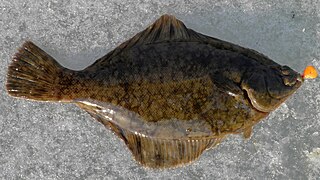 W
WPseudopleuronectes obscurus, or dark flounder is a flatfish of the family Pleuronectidae. It is a demersal fish that lives on salt bottoms in the temperate waters of the northwestern Pacific, from Hokkaido to the Kuril Islands, the Sea of Okhotsk, Sakhalin and the Tatar Strait to the northeastern coast of Korea and the Yellow Sea. It can grow up to 56 centimetres (22 in) in length, though it more commonly reaches around 35 centimetres (14 in), and its maximum recorded weight is 2.6 kilograms (5.7 lb).
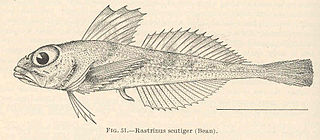 W
WRastrinus scutiger is a species of sculpins found from the Gulf of Alaska to the Bering Sea in the northeastern Pacific Ocean. It is a deep water species, occurring at depths of from 100 to 740 metres, most commonly found at 200 to 300 metres. This species grows to a length of 16 centimetres (6.3 in) TL. This species is the only known member of the genus Rastrinus.
 W
WSebastes aurora is a species of fish in the rockfish family found in the North Pacific. It is commonly known as the aurora rockfish.
 W
WSebastes diploproa, commonly known as the splitnose rockfish, is a species of fish in the rockfish family found in the Northeast Pacific.
 W
WThe sebastes goodei is a type of rockfish (Sebastidae) that lives mainly off the coast of western North America from Baja California to Vancouver. It is commonly called the Chilipepper rockfish and Chilipepper seaperch.
 W
WSebastes serranoides is a species of fish in the rockfish family found in the Eastern Pacific.
 W
WThe shortspine thornyhead is a species of fish in the family Sebastidae. It is sometimes referred to as the "idiot fish" or "idiot cod" due to its large oversize head/eyes. It is found in Canada, Russia, and the United States. Adult S. alascanus live predominantly in the oxygen minimum zone (OMZ), and thus require specific adaptations/exaptations in order to overcome the problems posed by the extremely low levels of oxygen saturation. Allowing for an increased ventilation frequency during exposure to progressively hypoxic conditions, as compared to its more shallow relative Scorpaena guttata, enables S. alascanus to compensate for the inherent low concentrations of oxygen in the OMZ. Further, heightened levels of lactate dehydrogenase, specifically the anaerobic isoform- LDH-A in the heart and muscles of S. alascanus, suggests an adaptive mechanism for ATP production during low oxygen availability.
 W
WStarksia cremnobates, the fugitive blenny, is a species of labrisomid blenny endemic to the Gulf of California where it is found at depths of around 60 metres (200 ft).
 W
WThe stripedfin ronquil is a fish native to the eastern Pacific Ocean. Its range is from San Francisco, California to northern Baja California, Mexico. It can reach a total length of 16 cm, and is elongated with a characteristic black and white pattern along the body. It inhabits rocky and sandy areas on exposed coasts as well as kelp forests. Its depth range is from approximately 6 to 91 meters. Its food consists of various invertebrates. The male guards the eggs.
 W
WThe sunset wrasse is a species of wrasse native to the eastern Pacific Ocean, where it can be found from Mexico to Peru. It is an inhabitant of reefs at depths from 3 to 42 m. It can grow to 32 cm (13 in) in total length.
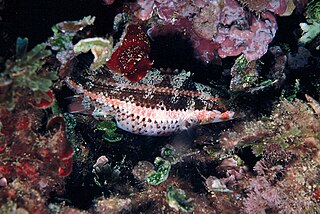 W
WSymphodus doderleini is a species of wrasse native to the coasts of the Mediterranean Sea through the Sea of Marmara. It can be found in beds of eelgrass at depths of from 2 to 40 m, and can reach 10 cm (3.9 in) in standard length.
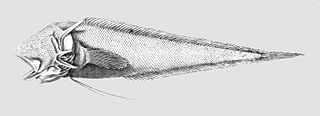 W
WTauredophidium hextii is a species of cusk-eel found in the Indian and western Pacific Oceans. It occurs at depths of from 1,500 to 2,660 metres. This species grows to a length of 10.5 centimetres (4.1 in) SL. It is the only known member of its genus. The specific name honours Rear-Admiral John Hext (1842-1924) who was commander of the Royal Indian Marine who supported the expedition in board the R.I.M.S. Investigator in the Arabian Sea which collected the type specimen.
 W
WThe totoaba or totuava is a species of marine fish, a very large member of the drum family Sciaenidae that is endemic to the Gulf of California in Mexico. It is the only species in the genus Totoaba. Formerly abundant and subject to an intensive fishery, the totoaba has become rare, and is listed on CITES Appendix I, as critically endangered on the IUCN Red List, and as 'endangered' under the Endangered Species Act.
 W
WXenocys jessiae is a species of grunt endemic to the Galapagos Islands where it is found along rocky slopes at depths from 3 to 18 m. This species grows to 30 cm (12 in) TL. This species is the only known member of its genus.